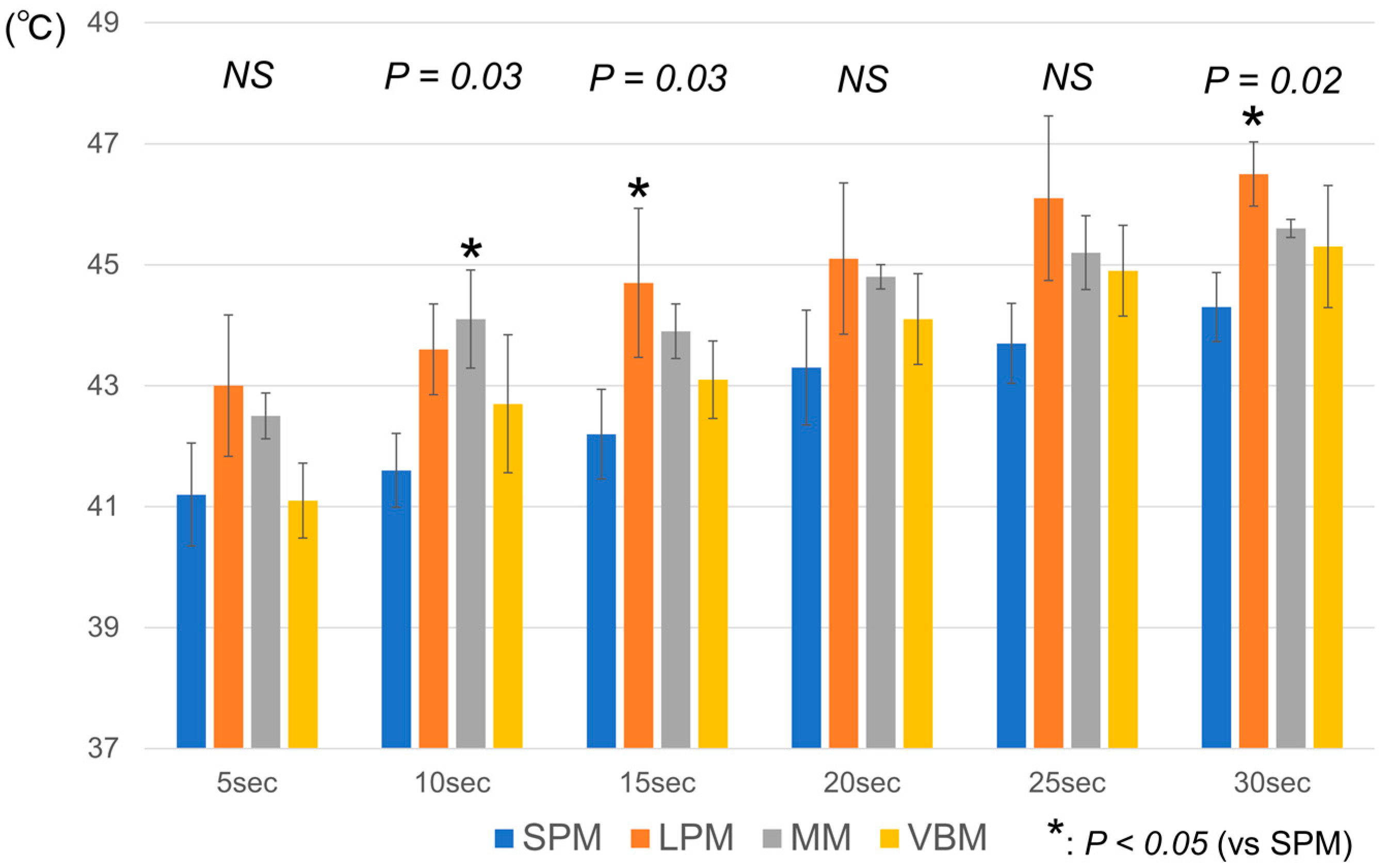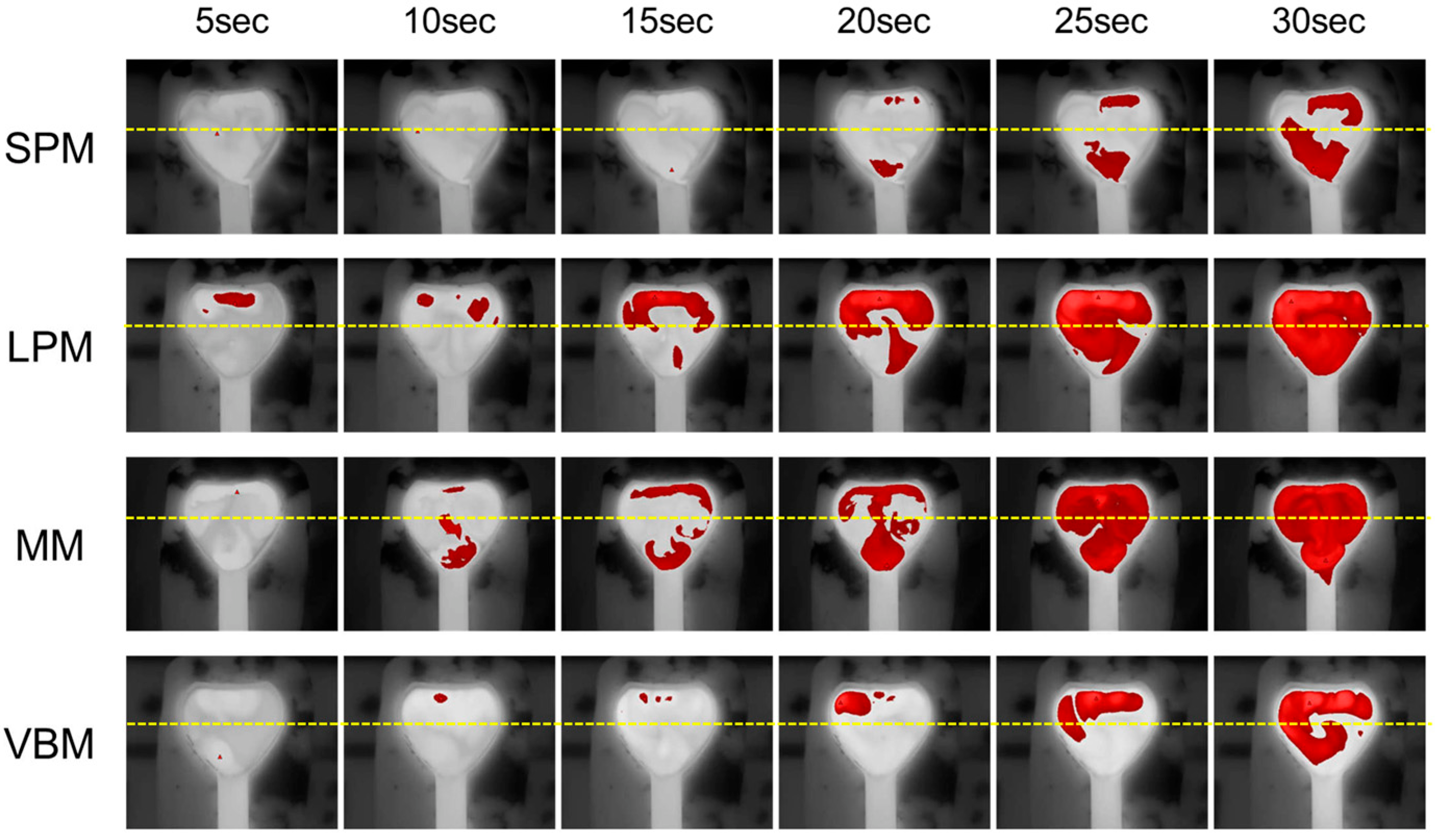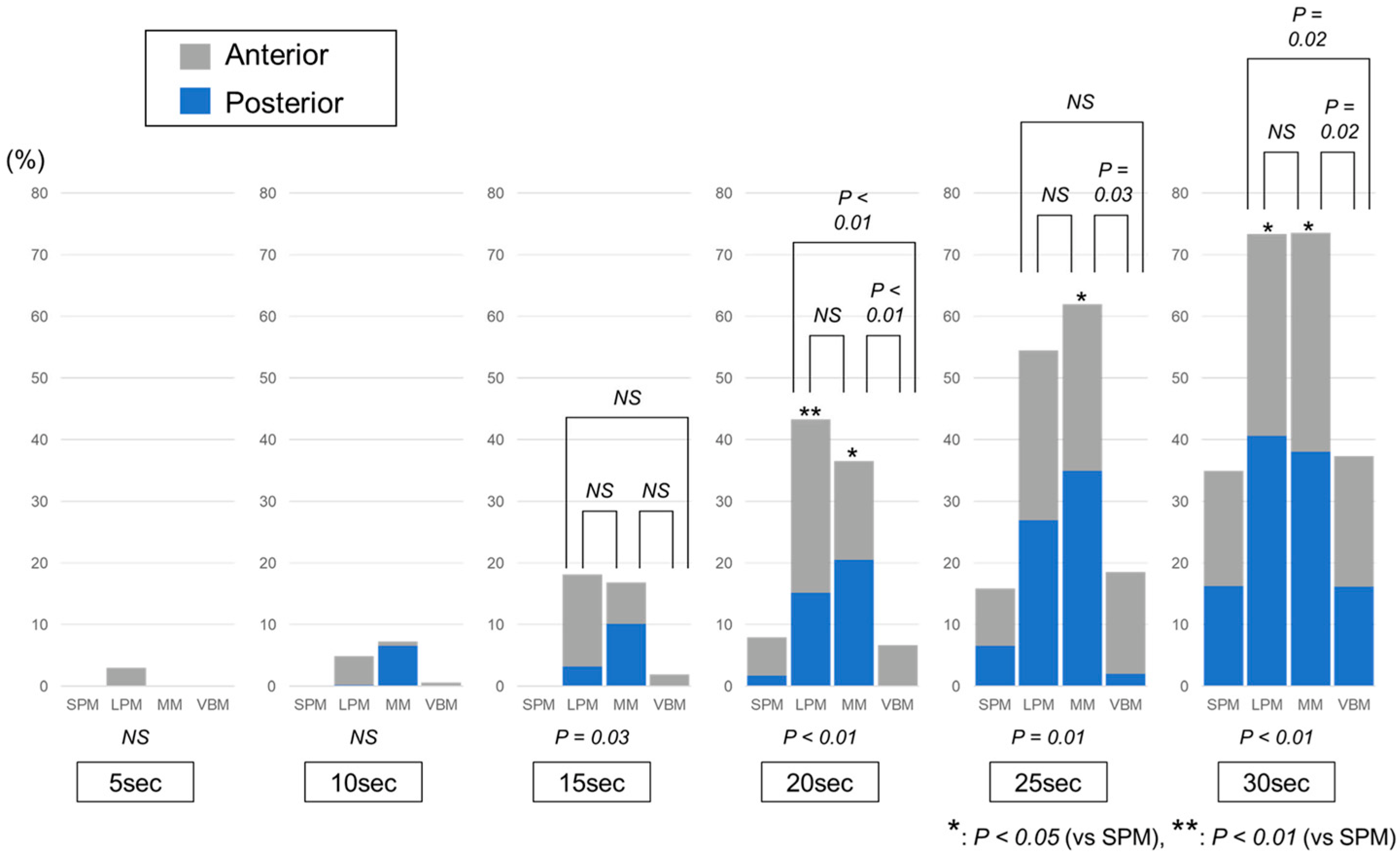Dynamic Changes in Fluid Temperatures during Laser Irradiation Using Various Laser Modes: A Thermography-Based In Vitro Phantom Study
Abstract
:1. Introduction
2. Materials and Methods
3. Results
3.1. Comparison of the Maximum Temperatures of the Water Surface
3.2. Comparison of the Ratios of High-Temperature Areas above the Threshold
4. Discussion
5. Conclusions
Author Contributions
Funding
Institutional Review Board Statement
Informed Consent Statement
Data Availability Statement
Acknowledgments
Conflicts of Interest
References
- Oberlin, D.T.; Flum, A.S.; Bachrach, L.; Matulewicz, R.S.; Flury, S.C. Contemporary surgical trends in the management of upper tract calculi. J. Urol. 2015, 193, 880–884. [Google Scholar] [CrossRef] [PubMed]
- Hein, S.; Petzold, R.; Schoenthaler, M.; Wetterauer, U.; Miernik, A. Thermal effects of Ho: YAG laser lithotripsy: Real-time evaluation in an in vitro model. World J. Urol. 2018, 36, 1469–1475. [Google Scholar] [CrossRef]
- Aldoukhi, A.H.; Hall, T.L.; Ghani, K.R.; Maxwell, A.D.; MacConaghy, B.; Roberts, W.W. Caliceal Fluid Temperature During High-Power Holmium Laser Lithotripsy in an In Vivo Porcine Model. J. Endourol. Endourol. Soc. 2018, 32, 724–729. [Google Scholar] [CrossRef] [PubMed]
- Winship, B.; Terry, R.; Boydston, K.; Carlos, E.; Wollin, D.; Peters, C.; Li, J.; Preminger, G.; Lipkin, M. Holmium:Yttrium-Aluminum-Garnet Laser Pulse Type Affects Irrigation Temperatures in a Benchtop Ureteral Model. J. Endourol. Endourol. Soc. 2019, 33, 896–901. [Google Scholar] [CrossRef] [PubMed]
- Yamashita, S.; Inoue, T.; Imai, S.; Iwahashi, Y.; Deguchi, R.; Muraoka, S.; Kikkawa, K.; Kohjimoto, Y.; Fujisawa, M.; Hara, I. Thermography-based comparison of irrigation temperatures between Moses mode and virtual basket mode: An in-vitro phantom study. J. Endourol. Endourol. Soc. 2022, 37, 179–184. [Google Scholar] [CrossRef] [PubMed]
- Türk, C.; Petřík, A.; Sarica, K.; Seitz, C.; Skolarikos, A.; Straub, M.; Knoll, T. EAU Guidelines on Interventional Treatment for Urolithiasis. Eur. Urol. 2016, 69, 475–482. [Google Scholar] [CrossRef] [PubMed]
- Taratkin, M.; Laukhtina, E.; Singla, N.; Tarasov, A.; Alekseeva, T.; Enikeev, M.; Enikeev, D. How Lasers Ablate Stones: In Vitro Study of Laser Lithotripsy (Ho:YAG and Tm-Fiber Lasers) in Different Environments. J. Endourol. Endourol. Soc. 2021, 35, 931–936. [Google Scholar] [CrossRef] [PubMed]
- Chan, K.F.; Vassar, G.J.; Pfefer, T.J.; Teichman, J.M.; Glickman, R.D.; Weintraub, S.T.; Welch, A.J. Holmium:YAG laser lithotripsy: A dominant photothermal ablative mechanism with chemical decomposition of urinary calculi. Lasers Surg. Med. 1999, 25, 22–37. [Google Scholar] [CrossRef]
- Sapareto, S.A.; Dewey, W.C. Thermal dose determination in cancer therapy. Int. J. Radiat. Oncol. Biol. Phys. 1984, 10, 787–800. [Google Scholar] [CrossRef] [PubMed]
- Aldoukhi, A.H.; Ghani, K.R.; Hall, T.L.; Roberts, W.W. Thermal Response to High-Power Holmium Laser Lithotripsy. J. Endourol. Endourol. Soc. 2017, 31, 1308–1312. [Google Scholar] [CrossRef] [PubMed]
- Elhilali, M.M.; Badaan, S.; Ibrahim, A.; Andonian, S. Use of the Moses Technology to Improve Holmium Laser Lithotripsy Outcomes: A Preclinical Study. J. Endourol. Endourol. Soc. 2017, 31, 598–604. [Google Scholar] [CrossRef] [PubMed]
- Ballesta Martinez, B.; Peteinaris, A.; Tsaturyan, A.; Natsos, A.; Koukiou, G.; Vagionis, A.; Pagonis, K.; Obaidat, M.; Liourdi, D.; Vrettos, T.; et al. Stone ablation rates using innovative pulse modulation technology: Vapor tunnel, virtual basket, and bubble blast. An in vitro experimental study. Lasers Surg. Med. 2021, 54, 580–587. [Google Scholar] [CrossRef] [PubMed]
- Chan, K.F.; Pfefer, T.J.; Teichman, J.M.; Welch, A.J. A perspective on laser lithotripsy: The fragmentation processes. J. Endourol. Endourol. Soc. 2001, 15, 257–273. [Google Scholar] [CrossRef] [PubMed]
- Pietropaolo, A.; Bres-Niewada, E.; Skolarikos, A.; Liatsikos, E.; Kallidonis, P.; Aboumarzouk, O.; Tailly, T.; Proietti, S.; Traxer, O.; Giusti, G.; et al. Worldwide survey of flexible ureteroscopy practice: A survey from European Association of Urology sections of young academic urologists and uro-technology groups. Cent. Eur. J. Urol. 2019, 72, 393–397. [Google Scholar] [CrossRef]
- Humphreys, M.R.; Shah, O.D.; Monga, M.; Chang, Y.H.; Krambeck, A.E.; Sur, R.L.; Miller, N.L.; Knudsen, B.E.; Eisner, B.H.; Matlaga, B.R.; et al. Dusting versus Basketing during Ureteroscopy-Which Technique is More Efficacious? A Prospective Multicenter Trial from the EDGE Research Consortium. J. Urol. 2018, 199, 1272–1276. [Google Scholar] [CrossRef] [PubMed]





Disclaimer/Publisher’s Note: The statements, opinions and data contained in all publications are solely those of the individual author(s) and contributor(s) and not of MDPI and/or the editor(s). MDPI and/or the editor(s) disclaim responsibility for any injury to people or property resulting from any ideas, methods, instructions or products referred to in the content. |
© 2023 by the authors. Licensee MDPI, Basel, Switzerland. This article is an open access article distributed under the terms and conditions of the Creative Commons Attribution (CC BY) license (https://creativecommons.org/licenses/by/4.0/).
Share and Cite
Yamashita, S.; Inoue, T.; Imai, S.; Maruyama, Y.; Iwahashi, Y.; Deguchi, R.; Kohjimoto, Y.; Fujisawa, M.; Hara, I. Dynamic Changes in Fluid Temperatures during Laser Irradiation Using Various Laser Modes: A Thermography-Based In Vitro Phantom Study. J. Clin. Med. 2023, 12, 1409. https://doi.org/10.3390/jcm12041409
Yamashita S, Inoue T, Imai S, Maruyama Y, Iwahashi Y, Deguchi R, Kohjimoto Y, Fujisawa M, Hara I. Dynamic Changes in Fluid Temperatures during Laser Irradiation Using Various Laser Modes: A Thermography-Based In Vitro Phantom Study. Journal of Clinical Medicine. 2023; 12(4):1409. https://doi.org/10.3390/jcm12041409
Chicago/Turabian StyleYamashita, Shimpei, Takaaki Inoue, Satoshi Imai, Yohei Maruyama, Yuya Iwahashi, Ryusuke Deguchi, Yasuo Kohjimoto, Masato Fujisawa, and Isao Hara. 2023. "Dynamic Changes in Fluid Temperatures during Laser Irradiation Using Various Laser Modes: A Thermography-Based In Vitro Phantom Study" Journal of Clinical Medicine 12, no. 4: 1409. https://doi.org/10.3390/jcm12041409
APA StyleYamashita, S., Inoue, T., Imai, S., Maruyama, Y., Iwahashi, Y., Deguchi, R., Kohjimoto, Y., Fujisawa, M., & Hara, I. (2023). Dynamic Changes in Fluid Temperatures during Laser Irradiation Using Various Laser Modes: A Thermography-Based In Vitro Phantom Study. Journal of Clinical Medicine, 12(4), 1409. https://doi.org/10.3390/jcm12041409






